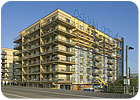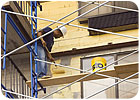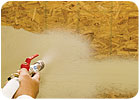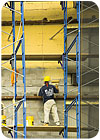
There are many choices for cladding available today for your residential or commercial project. Some are more energy efficient than others and it’s important, no matter what siding you choose, to protect your investment. A waterproofing/air barrier is an important component to any job whether you are using stucco, EIFS, brick, stone, or other siding options. A waterproofing/ air barrier, simply put, helps solve envelope problems, no matter what cladding is used.
In all types of construction, the uncontrolled entry of water into the building envelope can result in deterioration of elements within the envelope. Proper integration of the air barrier/waterproofing membrane with other components and proper water management techniques, like the “3-D” approach: Deflect-Drain-Dry, will effectively stop water penetration.
DEFLECT
Effective strategies for keeping water out of wall assemblies use the outermost face of the cladding and other exposed components of the wall assembly (e.g., windows) as the principal barriers against water penetration. This is the main water-shedding surface. Secondary barriers behind the cladding should be redundant layers of protection, in the engineering sense. In a properly designed and constructed wall assembly, the secondary protective layers should never get wet. Installing an airtight, waterproof membrane behind the wall cladding is an important component in the “3-D” defense strategy. The cladding itself, with an effective air barrier behind it, will deflect water from penetrating. This is the most important concept in stopping leaks.DRAIN
Draining is less important than deflection but if there is the assumption that some water might penetrate the cladding, for whatever reason, then provisions can be made to direct it to a flashing and out of the wall.
DRY
Drying is the least important of the three functions. In the event that some penetration and drainage may occur, some water will be retained in the drainage cavity simply by surface tension. This water should be allowed to dry by diffusion through the cladding to the exterior, through the wall assembly to the interior, or by ventilation.By using a waterproofing/air barrier and the cladding of your choice, you should rest easy that your completed project will be energy-efficient and long lasting.

TYPES OF CLADDINGS
EIFS were introduced in the United States more than 30 years ago and were developed in Europe in the 1950s. First used in the commercial market, EIFS is gaining popularity in the home industry today. EIFS consists of insulation board which is secured to the exterior wall surface, a durable, water-resistant base coat applied on top of the insulation and reinforced with fiberglass mesh for added strength, and a durable finish coat which holds its color and is crack-resistant. According to EIMA, the growing popularity of EIFS is due to the fact that few, if any, competitive materials offer such a wide range of desirable product benefits.Continuous exterior insulation provides significant energy savings and superior interior climate control and comfort. Exterior air and moisture infiltration at the foundation and wall joints, wall outlets and vents is reduced by as much as 55 percent compared to typical construction.
Heat loss through the walls, which accounts for up to 40 percent of heat loss in non-EIFS construction, is greatly reduced when using EIFS. EIFS also adds to the R-value of a home or building. The R-value is a measurement of the resistance to heat flow. The higher the R-value, the better the material’s insulating value. Most EIFS use insulation board with an R-value of R-4 to R-5.6 per inch as the innermost layers in the wall system. When combined with standard wall cavity insulation, this extra layer can boost wall insulation from R-11 to R-16 or more, according to EIMA.
Stucco has a long-lived reputation for being a low maintenance cladding. Stucco, in most cases, is a blend of Portland cement, sand, and lime that produces a durable, and cost effective cladding for the residential and commercial markets. Stucco has many advantages over other claddings including the low maintenance element and it’s also easier to install with some of the new machine technology.
Stucco products are available from building materials outlets. According to the National One Coat Stucco Association, the product requires very little maintenance and is ideal in a wide variety of climates. One-coat stucco can be installed in one application to a thickness of only 3/8-inch minimum in lieu of three-coat application of 7/8- inch thickness. Some products are better applied in two coats, as the first coat bonds to a supporting base of concrete or masonry, or keys into a metal lath or wire lath plaster base, and the second coat brings the plaster surface out to the desired plane, even with the grounds of the stucco accessories.
Using an elastomeric finish with a stucco product helps to maintain its beauty and durability. Stucco is available in thousands of color options and with many different coatings and finishes to provide the look you want for any project, whether it be commercial or residential. An elastomeric finish can accommodate thermal movement caused by extreme temperature changes like those found in the southwestern region of the U.S.

BRICK AND OTHER CLADDING CHOICES
Contrary to popular belief, brick does absorb moisture and also needs an air barrier to be energy efficient and combat mold and moisture. Brick is the oldest manufactured building material, according to the Portland Cement Association. The first brick was created nearly 10,000 years ago. Clay brick came around about 5,000 years ago and has a history of providing shelter that is durable, comfortable, safe, and attractive. Brick doesn’t rot or dent and is termite-resistant. Like stucco and EIFS, brick is virtually maintenance free.When painting brick, you must make sure that any deficiencies are corrected first. For brickwork to function properly the wall must resist moisture penetration and be permeable to vapor from the structure. When brick is exposed to moisture it will naturally expand. Temperature can also cause brick to expand and contract so it’s important to incorporate expansion joints into brickwork. According to the Brick Industry Association, brick is not impervious to water and water can migrate into brickwork. Brickwork handles this moisture by either having a cavity or separation between itself and the wall behind it or by being so thick that it acts as a barrier to the water. But the best way to combat moisture problems in brick wall assemblies is to install an air barrier.
Stone, wood, fiber-cement, and vinyl sidings also can benefit with some sort of a waterproofing/air barrier.
FLUID-APPLIED BARRIERS
One of the best ways to protect your home or building is with a fluid-applied waterproofing/air barrier. While fluid-applied waterproofing/air barriers for wall assemblies have been manufactured in North America for more than 25 years, their use has only recently become popular as air leakage gains recognition as a potential source of moisture accumulation. Fluid-applied waterproofing/air barriers are rolled or sprayed onto masonry substrates or sheathing and become part of the structural wall.Due to the way they are applied, there are no fastener holes where water penetration may occur, and there is no potential for mislapping or tearing (as with many sheet goods). During construction, a fluid-applied barrier wraps the substrate completely, and does not have to be covered immediately with a cladding, as many of them are UV-resistant.
Another important distinction of a fluid-applied waterproofing/air barrier in wall assemblies is its mitigation of one of the major forces causing water infiltration into walls-pressure difference. In combination with venting and compartmentalization, a fluid-applied waterproofing/air barrier enables the pressure behind the cladding material to equalize with the outside. (This is only possible with structural air barriers.) The equalization prevents rainwater penetration caused by pressure differentials.
More and more people are making educated decisions on what type of cladding they want on their house or building. Maintenance issues, curb appeal, and longevity are all key in choosing a cladding. People are also conscious of some of the green issues that air barriers address: energy conservation, reduced mechanical load, indoor air quality and related issues of mold and material degradation. Some may not realize why they need an air barrier but appreciate a comfortable and energy efficient living and working environment. It’s our job to connect these two-air barriers and cladding-to offer the best cladding choice.
